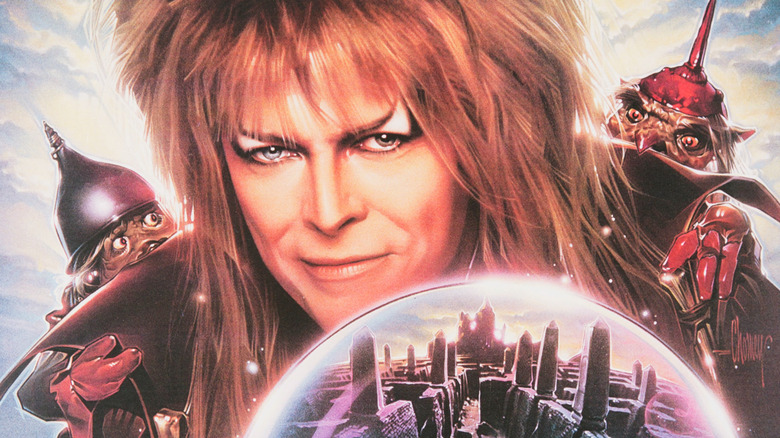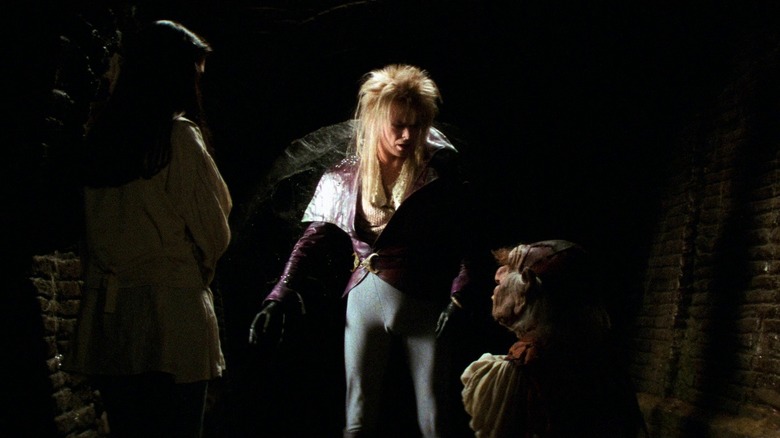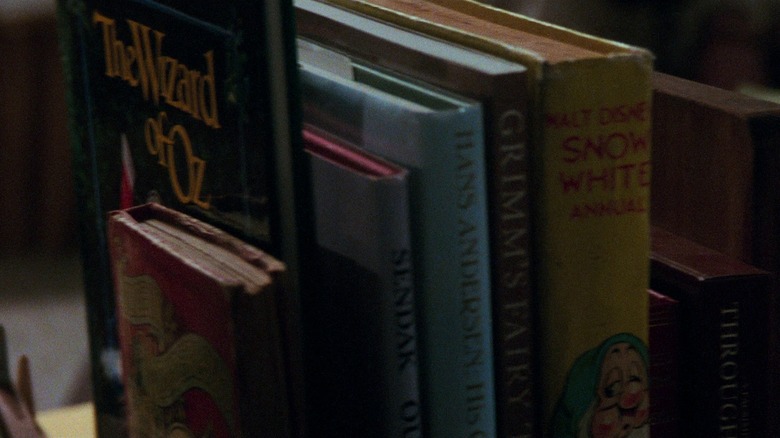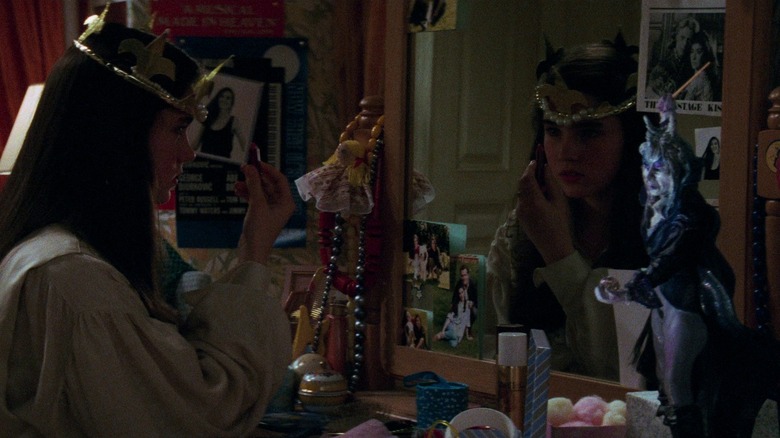Things About Labyrinth You Only Notice As An Adult
Few movies can compare to the brilliant artistry and creativity of Labyrinth (1986), a dark fantasy populated by quirky goblins, strange creatures, and a king who inspired non-PG thoughts in many admiring viewers. It starred a teenage Jennifer Connelly in the lead role of Sarah and featured David Bowie as Jareth the goblin king, who also wrote and recorded the soundtrack for the film.
With Jim Henson at the helm accompanied by screenwriter Terry Jones, producer George Lucas, and designer Brian Froud, Labyrinth was destined to be a cult classic, even though its initial box office reception was lackluster. And despite being billed as a movie for younger viewers, it's beloved by many adults even today. But if you haven't watched it lately, here are some of the things you might catch upon a repeat viewing as an adult.
Jareth is...packing
Let's get this one out of the way right from the start: Jareth's outfit doesn't leave much to the imagination. And while you're likely not to notice this as a kid — especially not the implications inherent in this sort of thing — it's literally impossible to miss as an adult. These magic pants serve to show Sarah that she's not in Kansas anymore when it comes to sexual maturity and awakening, and that adulthood is just around the corner.
Jareth's jewels are so popular that they have their own Facebook page, Tumblr, and a variety of other internet tributes including a Labyrinth drinking game. Clearly an impression has been made.
It's creepy that Jareth courts Sarah
Lots of women have distinct memories of feeling enchanted by Jareth as young girls, much in the same way they may have betrothed themselves to Atreyu from The Neverending Story. However, there's a big difference in these two experiences, namely that Atreyu is a youth, and Jareth is very much a grown man.
As an adult, it's downright creepy that the filmmakers suggested even a hint of romance between Sarah, who's only 16, and Jareth, let alone the prospect of marriage. There are laws against such a union in many parts of the world, so it's deeply concerning that such a courtship was perfectly acceptable in the eyes of 1986 Hollywood–though recent events may provide some unfortunately disturbing context on that subject. Top it off with the fact that Jareth has Hoggle feed Sarah a roofie-laden peach, and the whole thing seems even more sinister through an adult pair of eyes.
Sarah's library shows the movie's influences
Labyrinth drew from a number literary works for inspiration, including The Wizard of Oz, Snow White, and the Brothers Grimm, as well as the works of Maurice Sendak, Hans Christian Andersen, and Lewis Carroll. Blink and you miss it, but all of these works are on the shelves of Sarah's reading library in her room. You might not catch the shout-out as a kid, but once you've read the source material, the parallels are pretty obvious.
It's a classic coming-of-age fairy tale
Labyrinth, for the most part, follows the same formula that many classic fairy tales do, depicting Sarah's rite of passage out of childhood and into adulthood. At the start of the film, Sarah–our heroine–lives with her loving father and wicked stepmother. She's a precocious girl who finds solace in toys and books, which some may consider childish.
But her world is turned upside-down when, after complaining to forces that apparently were listening, her baby brother is kidnapped by the villain, Jareth; he then challenges her to win him back. This forces Sarah on a hero's journey through a mysterious and dangerous labyrinth, and eventually to the court of the goblin king himself. After a host of obstacles, tests, and missteps, Sarah eventually secures Toby's release after defeating Jareth and breaking the spell that he's cast. And while she may or may not live a happily ever after, order certainly is restored to her life, and the battle has been clearly won.
So while Labyrinth sure seems like one of the most unique and bizarre movies to have come out of the 1980s, its structure is actually much more traditional than you'd probably ever realized.
Sexual innuendos abound
The sexual innuendo and symbolism in Labyrinth is pretty blatant if you have your eye out for it. Once Sarah casts off her white gown and leaves the human world, she's no longer in pure, virginal territory. In fact, phalluses are everywhere. There's the obvious case of Jareth's aforementioned pants, for one. And he's either playing with a handful of crystal balls or wielding a scepter throughout the film. Then there's the promise of a "love injection" in the lyrics of the song, "Underground." During the masquerade ball, some of the guests are wearing masks with giant, phallic shaped noses, while Sarah dances with Jareth in an adorned white gown. Even Hoggle has his junk out when he and Sarah meet, as he's urinating into a pond.
What does it all mean? Well, here's one guess...
The labyrinth is Sarah's subconscious mind
If you took a psychology course in college or have an appreciation of the work of Carl Jung, maybe you picked up on the idea that the labyrinth is actually a reflection of Sarah's subconscious mind. For one, the labyrinth is surreal in many ways, as dreams are, and many things are not what they seem. Sarah finds that doors are not where they appear to be–and where they should be, they're missing. Also, many of the objects in her room–an MC Escher poster, a wooden marble labyrinth, and a statue of Jareth–are all found in some way in the labyrinth, which is further evidence that it's all a creation of her mind. And Jareth represents the looming possibility of sex, with his imposing stature and intimidating bulge. If only all of our subconscious minds were so interesting.
Sarah's stepmother thinks she should be dating
Jennifer Connelly was only 14 years old when she stepped into the role of 16 year old Sarah, which is fairly young — certainly pretty young to start dating in earnest. But Sarah's stepmother seems to have no issue with it, and in fact wishes Sarah would show some interest in the prospect, just as she did at her age. She says so in their only conversation together in the film. As a kid, you might miss how unsettling it is for a mother figure to push a young girl into the shark-infested dating pool so soon, but as an adult, it's pretty cringe-worthy.
It's supposed to be dark
In spite of the fact that Labyrinth is a beloved cult classic, it didn't do so well at the box office. In fact, it flopped. That's likely because people showed up to the theater expecting more typical Jim Henson fare like The Muppets, and Labyrinth is much darker and stranger.
But it's supposed to be dark, and it intentionally bucked the Hollywood trend of the era by subscribing to the notion that childhood can be a scary place, like the works of the Brothers Grimm and Hans Christian Andersen. Stories in those traditions depict The Little Mermaid feeling knives in her feet with every step, and Cinderella's step-sisters cut their feet in an attempt to wear the glass slipper — that's a far cry from their Disney counterparts.
So the danger of losing her brother forever, of unknown passages, of Jareth and his goblins, and of potentially smelling awful for the rest of your life really does resonate with kids, because childhood is not always a safe or fun place.
Sarah's mirror is a Bowie shrine
Apparently Sarah had a thing for David Bowie, even before she entered the labyrinth. It's evidenced by the fact that her vanity table is a veritable David Bowie shrine. There's the aforementioned stature of Jareth, as well as several pictures of him stuck to her mirror. Many women who grew up in the '80s can attest that she's not the only person who's done this.
Hoggle is literally two-faced
Of all of the folks that Sarah encounters in the Labyrinth, it's arguable that Hoggle is her closest ally. However, Hoggle is problematic for our heroine. For one, there's literally a face on the back of his jacket, which is an obvious indicator that he's, well, two-faced. He tells Sarah that they're friends, but then later he runs away and says in fact he isn't her friend. Plus he's still doing Jareth's bidding, and feeds Sarah a drugged fruit at Jareth's behest, which prompts Sarah to forget her mission, albeit temporarily. And he's not just two-faced to Sarah: he also defies Jareth's commands to aide Sarah, again running away to deflect any punishment. At the end of the day, Hoggle's all about Hoggle, and no one else.
Magic Dance offers questionable parenting advice
David Bowie's soundtrack for Labyrinth has stood the test of time, just like the movie. That said, some of the lyrical content doesn't always promote best practices. Most notably, "Magic Dance" provides some dubious advice for parents and caretakers of children — namely, if you're trying to cure your little one of the blues, it commands you to, "slap that baby" in order to "make him free." Countless experts would advise against that practice.
Hoggle's love for jewelry subverts masculine norms
In contemporary western society, adorning yourself with jewelry is typically considered to be a feminine act. Men will wear some jewelry, such as wedding bands, religious necklaces, or cufflinks, but usually it's women who pierce their ears, receive engagement rings, and customize their outfits with carefully curated accessories. But Hoggle isn't here for any of that. Rather, he unapologetically loves jewelry, as he tells Sarah, and is overwhelmed when she gifts him her bracelet. Hoggle isn't here for capitalism either, as he treasures that plastic like it's diamonds and pearls.
So he's understandably freaked out when Sarah takes his jewels away, and in an ableist move, holds his stash over his head where he can't reach it. Fortunately he gets it back, and can resume his own personal jewelry curation.
It fails the Bechdel Test
Technically Labyrinth fails the Bechdel Test. While Sarah does talk to both her step-mother and the bag lady about topics other than men, neither of those characters have been given a name. Additionally, literally everyone else in the movie (except for the fairies that Hoggle is assaulting at the beginning) is presumably male (do door-knockers have genders?), albeit mostly non-human. But in spite of this, Labyrinth has a lot going for it insofar as feminism is concerned. For one, the protagonist is female, and her character is multi-dimensional and developed. She also gets stronger and more independent throughout the movie as she progresses through the labyrinth and evades Jareth's many obstacles. Without Labyrinth, would we have The Craft or Buffy?
It has a feminist ending
In most fairy tales, the heroine of the story gets married–think Cinderella, Sleeping Beauty, and Snow White. But Sarah isn't your typical fairy tale heroine, and so she rejects Jareth's offer of marriage even though it would have made her a queen. That's because she doesn't need his power, as she already has an immense amount of her own, and she finally starts to realize it toward the end of the film.
During their final confrontation, she recites the self-affirming lines from the play she was performing in the beginning (but couldn't remember), culminating with a triumphant, "you have no power over me." This breaks the spell and sends Sarah back to her world, baby brother in tow. She might not be a queen surveying her goblin-populated domain, but she's home, which is what she wanted. Sarah got hers in the end.



